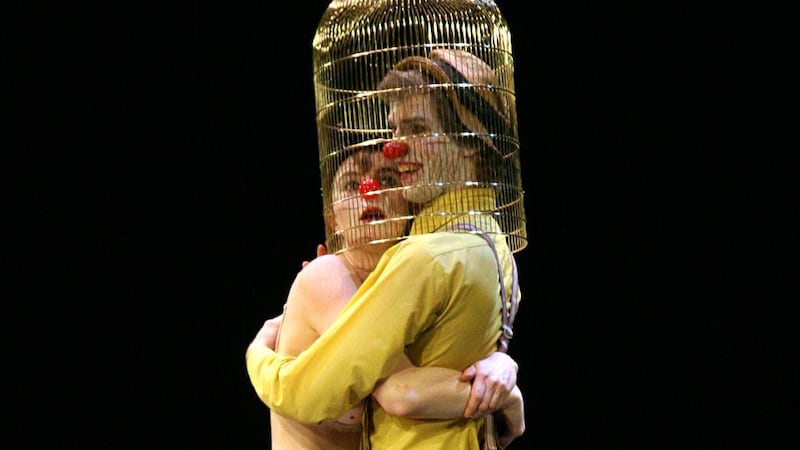It's only a teeny mask, and one that is hard to earn, yet a red nose has always held a particular attraction for Fionnuala Gallagher. So she's delighted that later this month, as part of the Múscailt arts festival in Galway, she's taking part in a "red nose clown exchange" between Ireland and Croatia.
The Sligo-born actor, theatre producer and director will be welcoming Lee Delong and colleagues from Triko Cirkus Teatar, in Zagreb, to stage Delong's Night of the Living Clown at An Taibhdhearc.
Clowning is the most authentic of all the theatre styles, according to Delong, a Paris-based disciple of the late mime and acting instructor Jacques Lecoq. "Since your clown is really you, there are no masks to hide behind," she says; to clown is to "search for what is human".

Delong learned most of her skills, which include styles of clowning such as “theatre clown, buffoon, hero and chorus, as well as singing, unicycling, balloon sculpting, juggling and waterskiing” – not to mention handling knives and guns – after a classical drama education at West Virginia University.
She has been visiting Ireland since she and Gallagher acted together in Paris in the 1980s. Those visits have included a collaboration with Judy Hegarty Lovett and Conor Lovett of Gare St Lazare Players, with whom Delong earned plaudits in Samuel Beckett's Worstward Ho, in Cork in 2005.
Delong became interested in teaching clown techniques during the civil war in the former Yugoslavia. With the support of the UN, she began to take military flights to Sarajevo, spending up to three months at a time working with locals. “These people needed a laugh,” she says. “I’ve trained a lot of clowns in the Balkans ever since.”
Her method is largely based on Lecoq's teachings but is also influenced by the French clown masters Alain Gautré and Philippe Gaulier, among others. "Losing the fear of being ridiculous is a great step for an actor to take, and his work is enriched by that step forever afterwards. The clown has no past and no future, so he exists only in the moment, which is a basic principle of all good acting skills," she says.
As Lecoq put it, there are many great actors who are not clowns, but there are no great clowns who are not great actors.
Marcel Marceau
Fionnuala Gallagher has had a link with clowning since her school days: she went to Scoil Ursula primary school in Sligo with Mikel Murfi, a founding member of Barabbas theatre company, and Niall Henry, one of the founders of Blue Raincoat theatre company. Their paths crossed again in Paris, when Murfi was a student at Lecoq's school of physical theatre and Henry was studying at Marcel Marceau's mime school.
In 1991 Henry and his Blue Raincoat cofounder, Malcolm Hamilton, invited Gallagher to join their company; the group went on to found the Factory performance space, and she performed in a number of productions, including Joe Orton's Loot – "I was the murderess" – and Peter Shaffer's Equus.
Every so often her inner clown beckoned. Gallagher remembers Barabbas's first show, Come Down from the Mountain John Clown, John Clown, which Murfi devised and performed with his Barabbas colleagues Veronica Coburn and Raymond Keane, and at one point she worked with Delong in Sligo at a month-long workshop in clowning for teenagers.
“I was the bystander, going around and getting them all out of bed and making sure they were okay,” Gallagher says. “Some of them were from big families, and this was their one chance to become involved in drama – and they thrived.”
Last October Gallagher organised a workshop with Delong at NUI Galway, where she is an arts officer. “Nine men arrived for it – it’s usually women who take the step to get involved in something different,” she says. “And it was three solid days of laughing. I think we laughed so much that our ribs and jaws hurt for a week.”
At the same time it was physically challenging. “There were tonnes of exercises, learning to exaggerate your walk, singing your worst song as if it if was your best. Once your nose is on, you are your clown and you are not allowed to think.” As Delong explains, the series of exercises challenges the participants to dig more deeply into themselves, to construct their clowns.
Gallagher subsequently signed up for a masterclass run by Delong in Zagreb, and it is the show she performed in as part of the class that is coming to Galway at the end of the month. “I will tweak it a bit,” Delong says, “but I won’t change the theme, which was written for Halloween.”
Gallagher has earned her red nose, she says, and has embarked on a “lifetime work of research in clown”.
Night of the Living Clown is at An Taibhdhearc, Galway, from February 27th to March 1st; antaibhdhearc.com. Múscailt arts festival opens at NUI Galway on Monday; muscailt.nuigalway.ie













